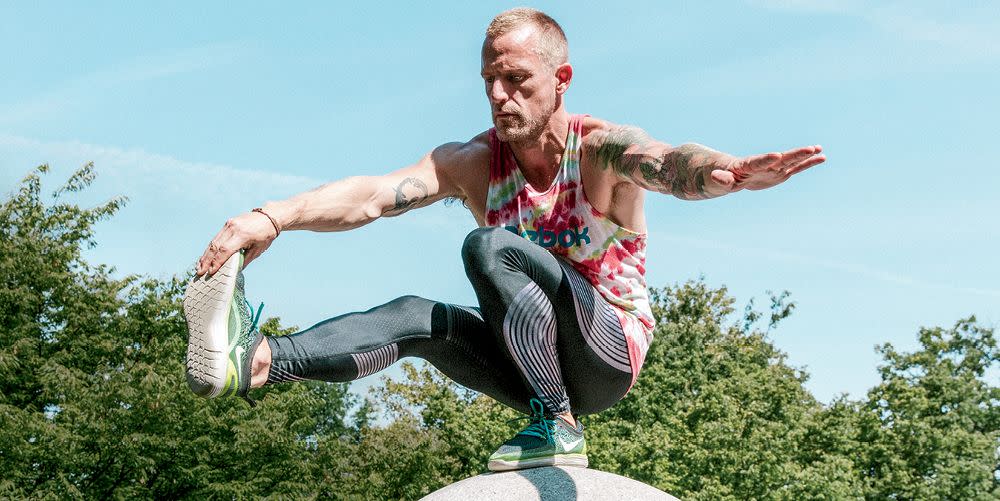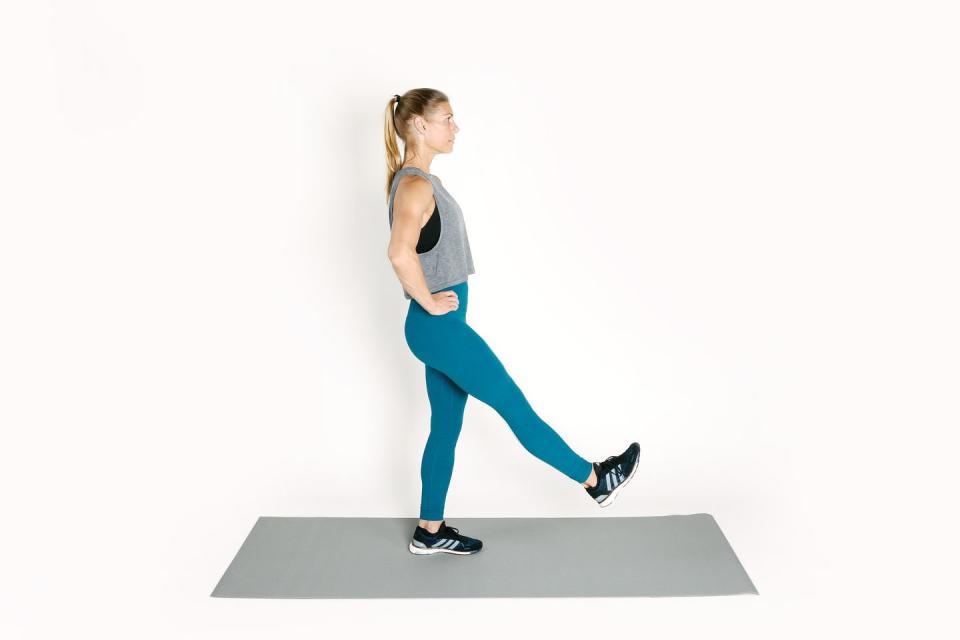The Pistol Squat Is a Tricky, Yet Beneficial, Move to Strengthen Your Muscles

Riki Bryan, founder of the Hard Boiled Holistics “functional movement studio” in New York City, has a surprising perspective on gyms: He doesn’t like them. “I’d rather be cycling or surfing or doing something fun outdoors,” he says. “But in NYC, it’s hard to do that on a daily basis. So, I thought, how do I keep my body ready for those times when I do those sports?”
The DJ, designer, and cyclist developed a unique fitness philosophy that borrows from tai chi, yoga, boxing, weight lifting, and bodyweight exercises. His workout system boosts strength, mobility, and flexibility—which has big benefits on the bike. And according to Bryan, the one move every cyclist should do when they’re not riding is a pistol squat.
“Cyclists need to narrow the imbalances between muscle groups,” says Bryan. “They can overdevelop their quads, which then start to pull on their knees; if you know any cyclists, you know cyclists who have knee issues. They don’t spend enough time developing the hamstrings, glutes, hips, and abdominals, and the supporting muscles that will help delay fatigue on long rides.”
For cyclists, Bryan recommends learning how to do a pistol squat properly, because the move activates the entire body and strengthens the muscles, such as glutes, adductors, and core, often neglected when we ride. Do this exercise two or three times a week, he says.
How to Master the Pistol Squat
This advanced move strengthens the quads, ankles, and core; boosts mobility in the ankles and knees; and works overall balance, says Bryan.
Because a proper pistol squat is difficult for even the most highly-trained athletes to perform correctly, you should always start with a modified version of the pistol squat before you progress to a more difficult version of this move.
We tapped Kara Miklaus, NASM-certified trainer and co-owner of WORK in Irvine, California and Kenny Santucci, certified personal trainer and owner of Strong New York, to break down the progression you need to master a pistol squat while staying injury-free.
Start With a Squat
First, master a traditional two-legged squat, because you’ll want to build leg muscles necessary for doing a single-leg squat suggests Miklaus. (Click here for more detailed information on mastering the perfect squat form). Before progressing to single-leg balance, you should be able to do 15 to 20 squats.
Next, Progress to a Single-Leg Balance
Once you’ve got the squat down, you can move on to building up your balance.

How to do it: Shift weight to one leg and maintain this position for about 10 seconds, then switch. Once you feet stable on each leg, you can also work on your balance at the bottom of the move. Start standing with feet shoulder-width apart. Squat down using both legs until you’re as low as you can hold, then lift one foot off the ground. Maintain this position on one leg for about 10 seconds, then switch. Then, return to starting position. Keep progressing the time spent on either leg to build up strength.
Then Progress to Assisted Pistol Squat
How to do it: Set TRX straps to mid-length. Facing anchor point, stand with feet hip-width apart and hold the handles in front of you. Shift weight onto left leg and extend right leg straight out in front of you. Slowly send hips back and bend left knee to squat toward the floor, keeping your heel grounded. Get as low into the squat as possible without losing your balance. Using your glutes, drive through left heel and use the TRX with arms to return to standing.
If you don’t have a suspension trainer, you can use a doorframe, heavy chair or couch, etc., to anchor you as you squat down and back up. Be sure to use the anchor point to assist you up and down, but maintain proper form and do the work with your lower body, rather than pulling up on what you’re supported with.
As you’re learning, aim for 3 sets of 5 on each leg. Before moving on to a Box or Chair Pistol Squat, you should master 15 to 20 reps on each leg.
Then Master Box/Chair Pistol Squat
How to do it: Stand with your back next to a chair or bench, then lift one leg off the ground and extend it out in front of you. Slowly lower until you’re seated. Then stand back up on the same leg. Shoot for 5 to 10 reps at that height, then make it more challenging by decreasing the height of the surface you’re sitting down on.
Before moving on, make sure you can comfortably and efficiently do 15 to 20 reps on each leg. If you don’t feel comfortable or confident removing the box and attempting the full motion, Santucci says that this modification is still enough to give you the full benefits.
Try a Counter-Weight Pistol Squat
While it may seem harder to add a weight to most moves, the weight here serves as a counter to your body weight as you send the hips back, making it slightly easier to balance.
How to do it: Start standing with feet shoulder-width apart, holding a light dumbbell or kettlebell (5 to 10 pounds). Pull shoulders back and keep back straight. Extend right leg and arms out in front of you. Slowly send hips back and bend left knee to squat toward the floor, keeping your heel grounded. Get as low into the squat as possible without losing your balance. Drive back up slowly. Exhale as you rise. Repeat on other side.
Finally, You’re Ready for a Pistol Squat
How to do it: Start standing with feet shoulder-width apart. Keep your chest high and eyes forward, pull your shoulders back and engage core. Extend arms and one leg out in front of you. Then, bend one knee, and hinge forward at your hips into a squat. Continue to lower, keeping your back straight and torso as upright as possible until you reach your full range of motion, or as close to 90 degrees as you can. (The goal is to bring your butt as close to your heel as you possibly can.) Then, squeeze your glutes and drive through your heel to stand back up.
When incorporating the move into your workout, Bryan suggests working at 80 percent of your maximum potential—if you can do five reps before significantly compromising your form, do 4 (8 to 12 would be “advanced,” says Bryan). Repeat with the left leg. That’s one set. Complete five sets, and rest to full recovery—about 90 seconds to two minutes—in between.
[WATCH] Next, Try These Workouts
You Might Also Like

